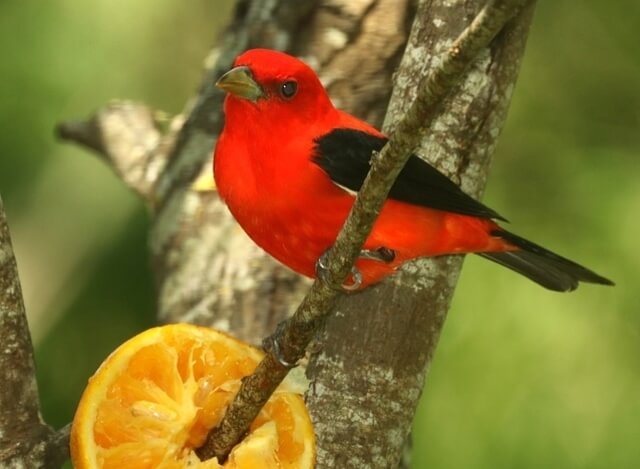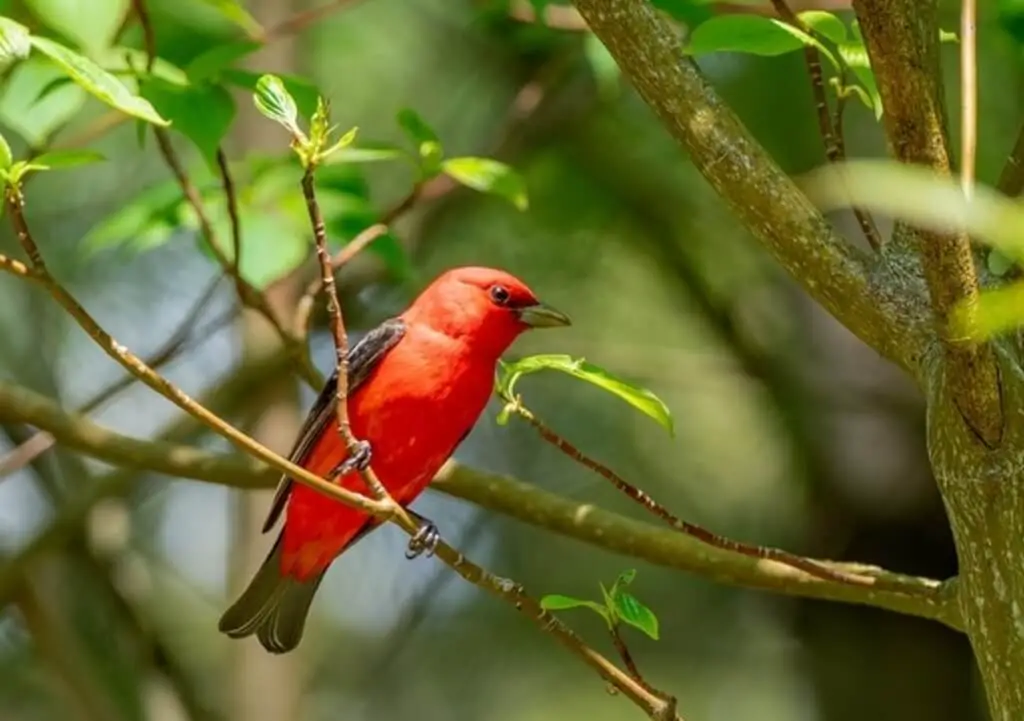
Do you want to attract western tanager to your yard? Are you a beginner who wants to know how to attract this beautiful bird, but don’t know where to start?
If so, then this article is perfect for you. We will be showing you everything you need to know in order to attract the scarlet tanager.
Table of Contents
- 1 Scarlet Tanager Identification
- 2 Scarlet Tanager Habitat
- 3 Attracting Scarlet Tanager At The Bird Feeder
- 4 Attracting Scarlet Tanager With A Birdbath
- 5 Attracting Scarlet Tanager With A Birdhouse
- 6 Trees That Attract Scarlet Tanager
- 7 Shrubs & Vines That Attract Scarlet Tanager
- 8 Flowers That Attract Scarlet Tanager
- 9 The Best Time To See Scarlet Tanager
- 10 Author
Scarlet Tanager Identification
Scarlet Tanagers are medium-sized songbirds, measuring about (15.2 to 19 cm) 6.0-7.5″ inches in length and weigh between 24 and 38.3 g (0.85 to 1.35 oz).
Males have a bright red body with black wings and tail with gray beaks, and they have black eyes which give them a distinctive look.
Female Tanagers are a dull yellowish-green throughout, with darker shading on the wings and tails, with gray beaks.
Scarlet Tanager Habitat
Scarlet Tanagers preferred habitat is in deciduous or mixed forests, suburbs, parks and open fields where they will often be seen hopping from branch to branch looking for berries or insects on which to feed.
Attracting Scarlet Tanager At The Bird Feeder
Many birders know that Scarlet Tanagers love eating oranges, but did you know they also enjoy mealworms and grape jelly? If you’re looking for the best food sources to attract this species of bird, then suet, mealworms, grape jelly or oranges are your best bets.
Other great sources of food include cherries, and cranberries which should be offered in winter months as they will not last long enough for summer feeding stations.
I find that I have the best success by using a suet feeder with suet cakes or use an orange fruit feeder with cut halved oranges. You can find all these products on Amazon for a good price.
Recommended Bird feeder and Food Choices:
- Suet Feeder (Use suet cakes)
- Fruit Feeder (Cut fruit such as oranges, apples, grapes, berries, raisins, or grape jelly)
- Platform Feeder (Use mealworms, or cut fruit)

Attracting Scarlet Tanager With A Birdbath
One of the most effective ways to attract them into your backyard is by using a birdbath. They are primarily attracted to water, and will flock to areas with plentiful sources of it.
Water sources are irresistible for Scarlet Tanagers and will be one of the first things they look for when considering where to set up their home. The best time for you to put out a birdbath is during their mating season in April and May.
However, they may still come in late summer if there’s not much competition from other birds. It can be placed near bushes or trees that provide cover for these birds.
You can purchase a birdbath like this one on Amazon, or it can be as simple as an old dishpan or bucket with stones placed around it to make it level. Make sure there is enough space for the birds to perch while they drink water.
Attracting Scarlet Tanager With A Birdhouse
These birds can be difficult to attract, and they may not visit your yard if you don’t provide them with the right type of shelter. A birdhouse will do just that.
These homes will provide shelter and nesting materials for these creatures, so they can raise their own families without any difficulty whatsoever. You can purchase a high quality birdhouse like this one on Amazon for a good price.
Trees That Attract Scarlet Tanager
Scarlet Tanagers are drawn to certain trees such as the oak tree, and it is possible to increase your chances of attracting them by planting some of these species in your yard.
The list below covers the most popular tree species for attracting scarlet tanagers to your yard:
- Pin Oak
- California Black Oak
- White Oak
- Northern Red Oak
- Cottonwood
- Willow
- Basswood
- Birch
- Elm
- Balsam Poplar
- Speckled Alder
- White Spruce
- Red Alder
- California incense-cedar
- Ash
- Beech
- Red Maple
- Hickory
- Wild Cherry
- Hemlock
- White Fir
- Sugar Pine
- Black Gum
- Douglas-fir
- Red Mulberry
- Apple Tree or Crab Apple
- Black Walnut
Shrubs & Vines That Attract Scarlet Tanager
Most people think of bird feeders when they are looking for a way to attract Scarlet Tanagers. But there are plants that will also help you entice these beautiful birds.
The best plants for this include vines and shrubs with berries, fruit, or flowers that have a strong smell. Here’s a list of eleven shrubs and vines below, that are known to entice them.
- Red Mulberry
- Service Berry
- Wild Grape
- Virginia Creeper
- Wild Blueberry
- Honeysuckle
- Ivy
- Carolina Jessamine
- Trumpet Creeper
- Fuchsia-Flowered Gooseberry
- Coral Honeysuckle Vine
Flowers That Attract Scarlet Tanager
The Scarlet Tanager is a stunningly beautiful bird that many people want to attract to their yard. While there are some flowers that they will visit, others will just be ignored.
To help you get the most out of your flower garden, here’s a list of five flowers and vines that will help you attract these birds:
1) Goldenrod- this yellow flower with an intense smell is very attractive to scarlet tanagers.
2) American Bittersweet Vine-The strong smell of the American Bittersweet Vine is a major attractant for Scarlet Tanagers.
3) Sweet Autumn Clematis- The vine has small flowers that are a deep, rich color which make it another excellent plant to bring in scarlet tanagers.
4) Eastern Redbud Tree- Scarlet Tanagers will also be attracted to this tree because of its fruit that tastes like raisins and sugar water.
5) Western Prairie Fringed Orchid- This beautiful orchid can be found in the desert and its flowers range from white to deep lavender.
The Best Time To See Scarlet Tanager
If you’re looking for these beautiful birds to make an appearance during your visit to the U.S., here’s a guide on when they may be most likely to show up:
- In spring (March through May), Scarlet Tanagers can be found mainly along the forest edges, foraging and searching for insects.
- Spring migration starts in late March, with summer sightings being common between June and August, with some even sticking around until October.
- They can be found mainly along forest edges during spring through May but will move to lower elevations in the fall.
- Fall migration begins as early as September, so you should start checking areas closer to your house before then if you want to see this beautiful bird while it’s still around!



